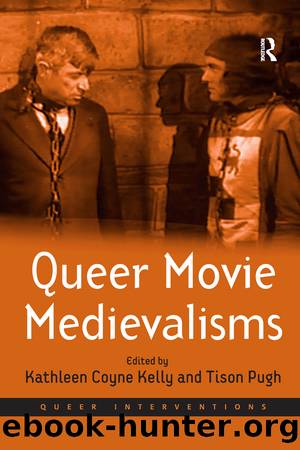Queer Movie Medievalisms by Tison Pugh Kathleen Coyne Kelly

Author:Tison Pugh, Kathleen Coyne Kelly [Tison Pugh, Kathleen Coyne Kelly]
Language: eng
Format: epub
ISBN: 9780367603083
Google: 9aaTzQEACAAJ
Publisher: Taylor & Francis Group
Published: 2020-06-30T01:28:28+00:00
The Violence Inherent in the System: Gender and Anti-Medievalism in the Holy Grail
In the scenes that I have discussed, The Holy Grail seems to have translated the Pythonsâ apparent investment in traditional gender roles to the medieval past. However, as in The Flying Circus, the troupeâs camp performances of genderâits hyper-enactmentâhas the potential to undermine its own gender politics. In the case of The Holy Grail, the filmâs narrative agenda, which (as I have argued elsewhere) uses an anti-medievalism to expose the âideal Middle Agesâ and their chivalric-feudal utopia as ludicrous constructs seeking to secure acquiescent subjects and not above resorting to violence when discourse fails, realizes this potential.15
The Holy Grail takes on a series of myths central to the rhetoric of British national identity, such as the appropriation of Arthur for the line of English kings, the fantasy of insular union, and the valorization of monarchy and class inherent in a neo-feudal society. The film thus enters into a debate about Britain and its monarchy that (tied as it was to larger issues of national and social identity) continually resurfaced during the Python years when the series of economic, social, and political woes discussed above precipitated a crisis of authority in England that undermined such myths, powerfully articulated in General de Gaulleâs 1961 words to the Queen: âBe the person in relation to whom, by virtue of your own legitimacy, all things in your Kingdom are ordered; the person in whom your people perceive their own nationhood; the person by whose presence and dignity, national unity is sustained.â16 By the late 1960s there was a growing sense that, far from symbolizing national stability, the royal family was both irrelevant and expensive. While more vocal republicans (most notably William Hamilton) called for the dissolution of the monarchy, the royal family attempted to repackage itself and the institution it represented.17 In 1969, under the auspices of Haseltine, âthe first press secretary who recognized a need to sell the monarchy to the public,â two television events were planned to do just that. The first, a BBC documentary entitled Royal Family, attempted to establish the royal family as a âmodel domestic family,â prompting a rhetoric of royalty based on its function as an exemplum to its people.18 The second, the Investiture of Prince Charles in Caernarvon, Wales, reverted to older arguments of royal transcendence. As Ziegler comments, âHere was the royal family deployed in all its most formal and hierarchical arrayâa reminder that for all the picnics and cosy viewings of Dadâs Army, there was still a mystery about the Crown, a religious and spiritual significance.â19
Ziegler, a royalist, clearly approves of the royal reminder; more republican commentators such as Nairn and Pimlott read the event quite differently. Both comment on the ceremonyâs use of âArthurian pantomime, mock medieval pageantry and Gothic revival wordsâ as âceremonial theatre to focus the attention of the British subjects and the Commonwealth on the self-renewing monarchyâ and to establish, especially for the restless Welsh and Irish nationalists, that
Download
This site does not store any files on its server. We only index and link to content provided by other sites. Please contact the content providers to delete copyright contents if any and email us, we'll remove relevant links or contents immediately.
Still Foolin’ ’Em by Billy Crystal(36209)
Spell It Out by David Crystal(35998)
The Great Music City by Andrea Baker(31093)
Professional Troublemaker by Luvvie Ajayi Jones(29545)
Trainspotting by Irvine Welsh(21459)
Call Me by Your Name by André Aciman(20324)
We're Going to Need More Wine by Gabrielle Union(18911)
The Secret History by Donna Tartt(18764)
Cat's cradle by Kurt Vonnegut(15107)
Ready Player One by Cline Ernest(14449)
Molly's Game by Molly Bloom(14029)
Bombshells: Glamour Girls of a Lifetime by Sullivan Steve(13933)
The Goal (Off-Campus #4) by Elle Kennedy(13377)
Leonardo da Vinci by Walter Isaacson(13112)
4 3 2 1: A Novel by Paul Auster(12231)
The Social Justice Warrior Handbook by Lisa De Pasquale(12087)
The Break by Marian Keyes(9269)
Crazy Rich Asians by Kevin Kwan(9132)
Adultolescence by Gabbie Hanna(8788)
